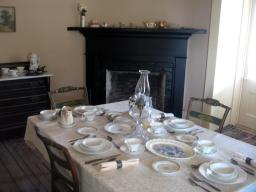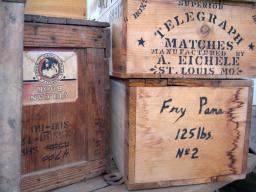- Slug: BC-CNS-Park Partnership,715
- Note: A Cronkite News Service Weekend Special
- Multimedia: Flash video for computers; YouTube video for iPhone.
- With: BC-CNS-Park Partnership-Box
- Photos available (thumbnails, captions below)
By TRAVIS GRABOW
Cronkite News Service
YUMA _ Yuma Quartermaster Depot State Historic Park preserves everything from original buildings like the commanding officer’s quarters to covered wagons that carried supplies to Army posts around the Southwest.
A rarer sight on the grounds these days is state employees: The park is now run not by the state but by a partnership put together by the city.
Unwilling to see the park close down even temporarily after budget cuts left Arizona State Parks reeling, the city offered to take over day-to-day operations here.
“Once you shut it down it deteriorates and starts to fall apart,” Yuma Mayor Larry Nelson said. “It needs constant maintenance.”
The park is part of the Yuma Crossing National Heritage Area, a stretch of riverfront that also includes Yuma Territorial Prison State Historic Park. A nonprofit group is spending $80 million to revitalize the heritage area to attract tourists and create an oasis for residents.
The Quartermaster Depot isn’t the only state park in peril. Oracle State Park and Jerome and McFarland state historic parks have closed down entirely, while more than a dozen parks have cut back their operating hours.
Earlier this month, Gov. Jan Brewer’s Task Force on Sustainable State Parks Funding recommended adding a voluntary surcharge of $14 or $15 on vehicle licenses. That recommendation drew from a report by Arizona State University’s Morrison Institute for Public Policy, which also mentioned partnerships between communities and the state among other options to keep parks open.
Nancy Welch, assistant director of the Morrison Institute, said Yuma has shown that a partnership can work. She also pointed to the city of Payson, which pitched in money and volunteers to reopen Tonto Natural Bridge State Park after a brief closure.
“It won’t work for every park; it depends on the local situation,” she said.
“Unfortunately, you can’t depend on those partnerships to really support the entire system,” Welch said, “but they’re a critical piece of support.”
In Yuma, the partnership has been trying to increase the number of visitors to the Quartermaster Depot _ it drew around 12,000 people in the 2008 fiscal year _ by moving Yuma Visitor Center into the park’s main building, replacing some of the historical exhibits and eliminating the park’s entrance fee.
The partnership also covers half of the salary of a seasonal park ranger, drawing on a hospitality tax that voters renewed earlier this year.
City Administrator Mark Watson said the investment is well worth it because the park helps lure tourists, increase sales taxes and support local businesses.
“We have the uniqueness of having a national heritage area, and this is a critical component of that,” he added.
Charles Flynn, director of the Yuma Crossing National Heritage Area, said that closing the park would have hurt efforts to revitalize the riverfront.
“For both economic reasons and historical reasons, we did not want to see that happen because what we’re trying to do is promote history as a basis for economic development.”
State parks have an economic impact estimated at $266 million a year, and because most parks are in rural areas they often are integral to the economies of smaller communities.
Jay Ziemann, assistant director of Arizona State Parks, said the agency is grateful to communities such as Yuma that have helped keep parks open. But he said the ultimate goal should be funding state parks.
“It’s not a long-term solution, and we need to step up to the plate and make sure that we are funding these places adequately,” he said. “So I guess while we’re thankful we need to do a better job.”
Flynn said he hopes the situation at the Quartermaster Depot is temporary and that the state will restore at least some financial support. In the meantime, he said the arrangement benefits Yuma.
“Given where we’re at, communities have to determine just how important these assets are,” he said. “And this is the best way to tell.”
Nelson, the mayor, said he’d prefer to have the state running the park and, even better, building it up.
“But the fact that we’re able to keep it open is important to me,” he said.
^___=
Web Link:
_ Arizona State Parks: www.azstateparks.gov
_ Yuma Crossing: www.yumaheritage.com
^___=
PHOTOS: Click thumbnails to see full-resolution images.

Mayor Larry Nelson said a partnership that has helped preserve Yuma Quartermaster Depot State Historic Park has benefited the city by keeping open one historic part of an area it promotes as Yuma Crossing. With Arizona State Parks struggling to cope with budget cuts, the city has stepped in to operate the park. (Cronkite News Service Photo by Travis Grabow)

A antique wagon accents the entrance to Yuma Quartermaster Depot State Historic Park. For years, the depot was the main U.S. Army supply base in the Southwest. With Arizona State Parks struggling to cope with budget cuts, Yuma has stepped in to operate the park. (Cronkite News Service Photo by Travis Grabow)

Yuma Quartermaster Depot State Historic Park features a replica of a wagon train. For years, the depot was the main U.S. Army supply base in the Southwest. With Arizona State Parks struggling to cope with budget cuts, Yuma has stepped in to operate the park. (Cronkite News Service Photo by Travis Grabow)

The commanding officer’s quarters are preserved as part of Yuma Quartermaster Depot State Historic Park. For years, the depot was the main U.S. Army supply base in the Southwest. With Arizona State Parks struggling to cope with budget cuts, Yuma has stepped in to operate the park. (Cronkite News Service Photo by Travis Grabow)

Yuma Quartermaster Depot State Historic Park preserves what used to be the main U.S. Army supply base in the Southwest. With Arizona State Parks struggling to cope with budget cuts, Yuma has stepped in to operate the park. (Cronkite News Service Photo by Travis Grabow)